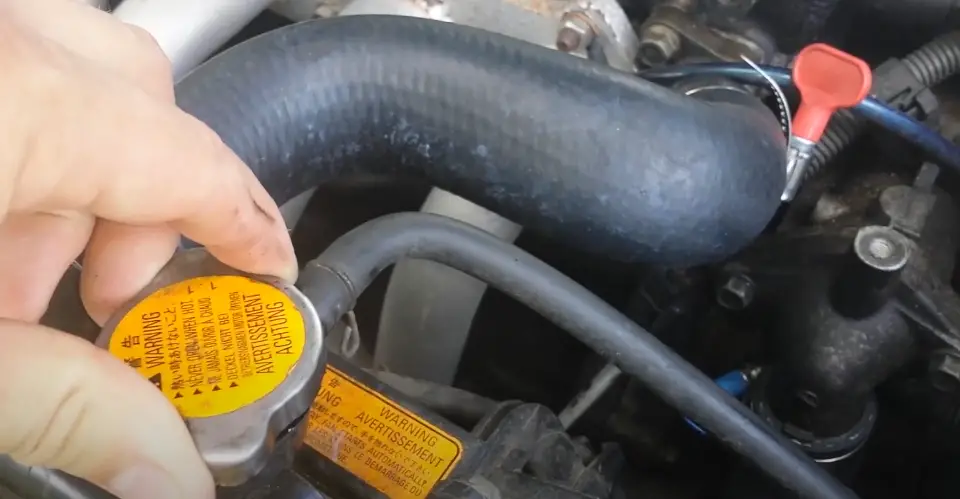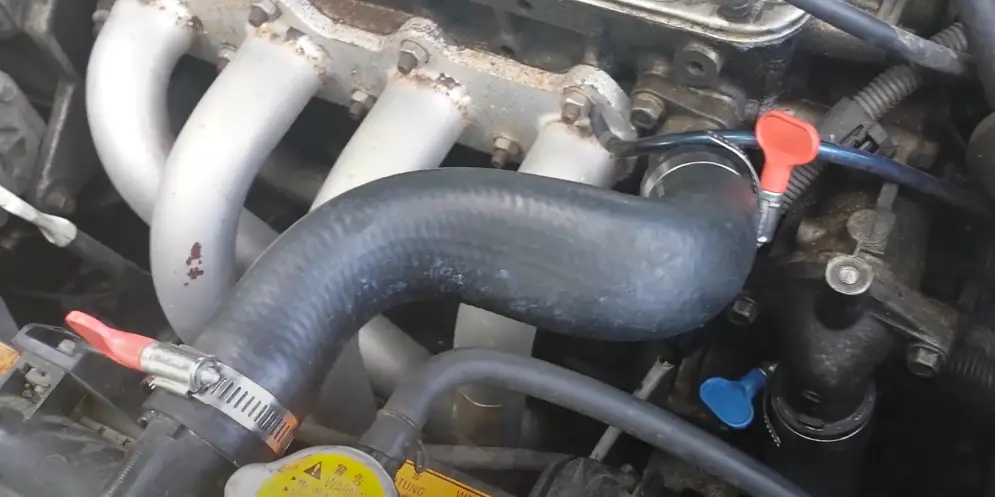A collapsing top radiator hose is usually caused by vacuum pressure build-up in the cooling system, often due to a faulty radiator cap or a blocked overflow tank. It can also result from a clogged radiator or low coolant levels. Addressing these issues promptly is crucial to prevent engine overheating and potential damage.
A collapsing top radiator hose is a concerning issue that can lead to engine overheating and significant damage if not addressed promptly. The radiator hose plays a crucial role in your vehicle’s cooling system, transporting coolant between the engine and radiator to regulate temperature. When the top radiator hose collapses, it can indicate several underlying problems that need immediate attention

Contents
Why Is My Top Radiator Hose Collapsing?
Several factors can cause the top radiator hose to collapse. Understanding why radiator hose collapse can help you diagnose and fix the issue before it leads to more serious problems.
1. Vacuum Pressure Build-Up
One of the most common reasons for a collapsing top radiator hose is vacuum pressure build-up within the cooling system. As the engine cools down, the coolant contracts and creates a vacuum that draws the coolant back from the overflow tank into the radiator. If there is a bad radiator cap or the overflow tank, the vacuum can become too strong, causing the hose to collapse.
Solution: Check the radiator cap for any signs of damage or wear. The cap has a spring-loaded valve that controls the pressure within the cooling system. If this valve is faulty, it can cause excessive vacuum pressure, leading to a collapsed hose. Replacing the radiator cap is often a simple and effective fix.
2. Clogged or Blocked Radiator
A clogged or blocked radiator can restrict the flow of coolant, creating a vacuum that causes the top radiator hose to collapse. Debris, rust, or sludge build-up inside the radiator can prevent the coolant from circulating properly, leading to pressure imbalances.
Solution: If you suspect a clogged radiator, it’s essential to flush the cooling system. A radiator flush involves draining the old coolant, cleaning the radiator, and refilling it with fresh coolant. If the radiator is severely clogged, it may need to be replaced.
3. Faulty or Blocked Overflow Tank
The overflow tank plays a critical role in maintaining the correct coolant level and pressure within the cooling system. If the overflow tank is blocked or the hose leading to it is kinked or clogged, it can prevent coolant from returning to the radiator, creating a vacuum that collapses the top radiator hose.
Solution: Inspect the overflow tank and the hose connecting it to the radiator. Clear any blockages, and ensure the hose is not kinked. If the overflow tank is damaged, consider replacing it to restore proper function.
4. Coolant Level Issues
Low coolant levels can lead to air pockets within the cooling system. These air pockets can cause pressure imbalances that may result in the top radiator hose collapsing. Additionally, low coolant levels can lead to overheating, which exacerbates the problem.
Solution: Regularly check and maintain the correct coolant level in your vehicle. If you notice that the coolant level is consistently low, inspect the system for leaks and repair them as needed. Topping off the coolant and bleeding the system to remove air pockets can prevent the hose from collapsing.
5. Aging or Worn-Out Radiator Hose
Radiator hoses are made of rubber or silicone, materials that can degrade over time due to heat, pressure, and chemical exposure. An aging or worn-out hose may lose its elasticity and become prone to collapsing, especially under vacuum pressure.
Solution: If your radiator hose is old or showing signs of wear (such as cracks, brittleness, or a soft texture), it’s time to replace it. Installing a new hose ensures that it can withstand the pressures and temperatures of the cooling system.
Effect of a Collapsed Radiator Hose
Ignoring a collapsed radiator hose can lead to several severe consequences, including:
1. Engine Overheating
A collapsed radiator hose restricts coolant flow, leading to insufficient cooling of the engine. Overheating can cause significant damage to the engine, including warping the cylinder head, blowing the head gasket, or even complete engine failure.
2. Coolant Leaks
A collapsed hose can develop cracks or splits due to the pressure imbalance. This can lead to coolant leaks, further reducing the coolant level and exacerbating overheating issues.
3. Reduced Engine Performance
As the engine temperature rises due to insufficient cooling, you may notice a drop in engine performance. This can manifest as sluggish acceleration, reduced power, or rough idling.
4. Costly Repairs
If a collapsed hose leads to engine overheating and subsequent damage, the cost of repairs can be significant. Replacing a damaged radiator hose early on is a cost-effective way to avoid these expensive repairs.
How to Prevent Radiator Hose Collapse
Preventing radiator hose collapse involves regular maintenance and timely replacement of worn-out components. Here are some best practices:
1. Regular Cooling System Inspections
Regularly inspect your cooling system, including the radiator hoses, radiator cap, and overflow tank. Look for signs of wear, leaks, or blockages that could lead to hose collapse.
2. Maintain Proper Coolant Levels
Check your coolant levels regularly and top up as needed. Ensure that the coolant is mixed to the correct ratio specified by your vehicle’s manufacturer. Low coolant levels can cause air pockets and pressure imbalances that lead to hose collapse.
3. Replace Worn or Aging Hoses
Radiator hoses should be replaced every 4 to 5 years or at the first sign of wear. Even if the hose appears to be in good condition, it may have lost its elasticity and be prone to collapsing under pressure.
4. Use High-Quality Replacement Parts
When replacing radiator hoses, use high-quality parts that meet or exceed OEM specifications. Inferior hoses may not withstand the pressures and temperatures of your vehicle’s cooling system, leading to premature failure.
5. Monitor Engine Temperature
Keep an eye on your engine’s temperature gauge. If you notice the temperature rising beyond normal levels, it could be a sign of cooling system issues, including a collapsing radiator hose.

Frequently Asked Questions
Here are some FAQs about the collapsing radiator hoses –
1. What causes a radiator hose to collapse?
A radiator hose can collapse due to vacuum pressure build-up, a clogged radiator, a blocked overflow tank, low coolant levels, or the aging of the hose material. Each of these issues can create pressure imbalances that cause the hose to lose its shape.
2. Can I drive with a collapsed radiator hose?
Driving with a collapsed radiator hose is not recommended, as it can restrict coolant flow and lead to engine overheating. If you notice a collapsed hose, it’s best to address the issue immediately to avoid engine damage.
3. How can I prevent my radiator hose from collapsing?
Preventing a collapsed radiator hose involves regular maintenance, including inspecting the cooling system, maintaining proper coolant levels, replacing worn radiator hoses, and using high-quality replacement parts. Ensuring that the radiator cap and overflow tank are functioning correctly is also crucial.
4. Should I replace both radiator hoses if one collapses?
If one radiator hose collapses, it’s a good idea to inspect the other hose for signs of wear or damage. While it’s not always necessary to replace both hoses simultaneously, doing so can prevent future issues, especially if the hoses are the same age.
5. How often should I replace my radiator hoses?
Radiator hoses replacement time should typically be every 4 to 5 years or at the first sign of wear, such as cracks, swelling, or softness. Regular inspections can help determine when replacement is necessary to avoid a collapsed hose and related issues.
Conclusion
A collapsing top radiator hose is a clear indication that something is wrong within your vehicle’s cooling system. Whether it’s due to vacuum pressure build-up, a clogged radiator, or aging hoses, addressing the issue promptly is essential to prevent engine overheating and potential damage.